Pizza Tips: History, Basic Ingredients, Simpliest Ways To Make
 |
| How To Make Pizza: What Is Pizza Made Of, Step By Step Guide |
Pizza is a dish of Italian origin consisting of a usually round, flat base of leavened wheat-based dough topped with tomatoes, cheese, and often various other ingredients (such as anchovies, mushrooms, onions, olives, pineapple, meat, etc.), which is then baked at a high temperature, traditionally in a wood-fired oven. A small pizza is sometimes called a pizzetta. A person who makes pizza is known as a pizzaiolo.
In Italy, pizza served in formal settings, such as at a restaurant, is presented unsliced, and is eaten with the use of a knife and fork. In casual settings, however, it is cut into wedges to be eaten while held in the hand.
Making a pizza can be a difficult process for beginners, but if you are thinking of trying your hands on this delicious dish, we are here to help you with how to make it.
A history of pizza
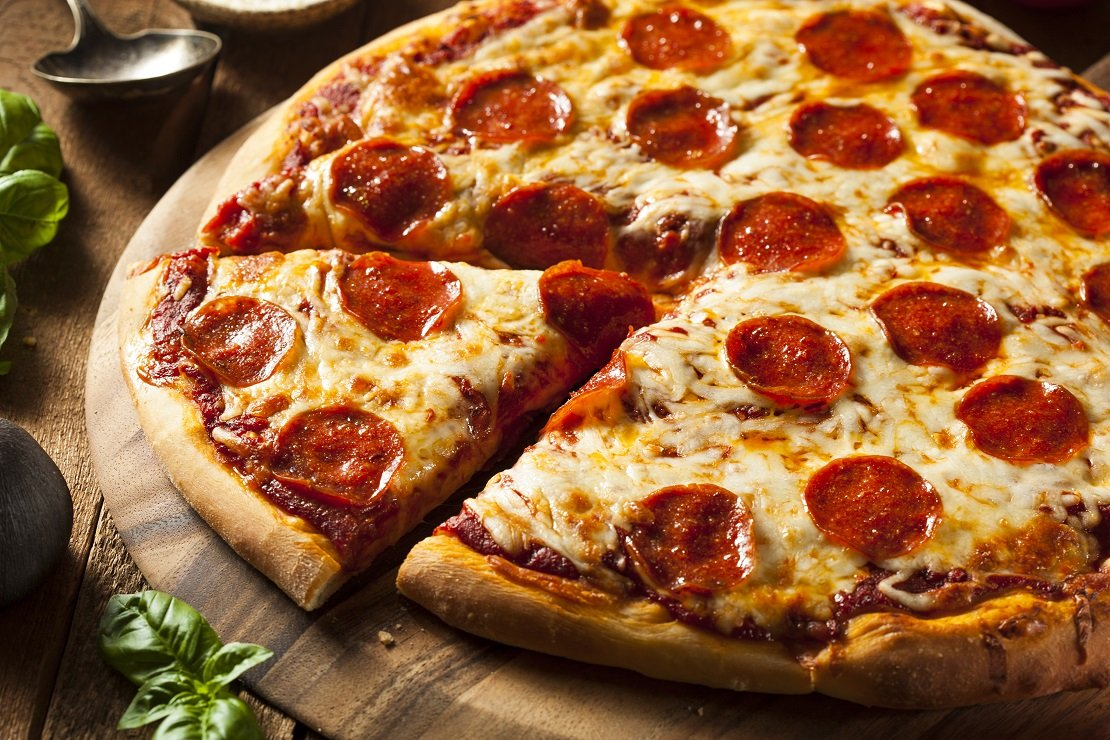 |
| Photo: Getty Images |
People have been eating pizza, in one form or another, for centuries. As far back as antiquity, pieces of flatbread, topped with savouries, served as a simple and tasty meal for those who could not afford plates, or who were on the go. These early pizzas appear in Virgil’s Aeneid. Shortly after arriving in Latium, Aeneas and his crew sat down beneath a tree and laid out ‘thin wheaten cakes as platters for their meal’. They then scattered them with mushrooms and herbs they had found in the woods and guzzled them down, crust and all, prompting Aeneas’ son Ascanius to exclaim: “Look! We’ve even eaten our plates!”
The idea of flatbreads with toppings is not an entirely new one. It dates back centuries ago when the Romans, Greeks, and Egyptians ate their bread in that form. They would place it on a hot stone or in mud ovens to make the bread, then they would spread their toppings, such as herbs or mushrooms, on the flatbread.
An interesting finding was a record of how soldiers baked flatbreads in ancient Persia. Their shields were their ovens.
In fact, in the 1st Century B.C., a Roman poet is found to have talked about circles of bread thought to look like a pizza. People cooked Pinsa on hot ashes in ancient Rome, and it comes closest to modern-day pizza.
Years later, in the 18th century, pizza would be born in Naples, a town in Italy. The pizza was not the delicacy it is now. In those days, Naples’s people ate pizza, which was just a flatbread with toppings, because it was cheap. Why? They were poor, and this was all they could afford. They couldn’t go to work on a hungry stomach, and one would see them munching these slices on their way.
As if to solidify a blended culture, pizza’s leap into fame came in just when Italy became unified. On their visit to Naples, King Umberto I and Queen Margherita were intent on trying out an Italian dish. They needed to break away from their usual French meals.
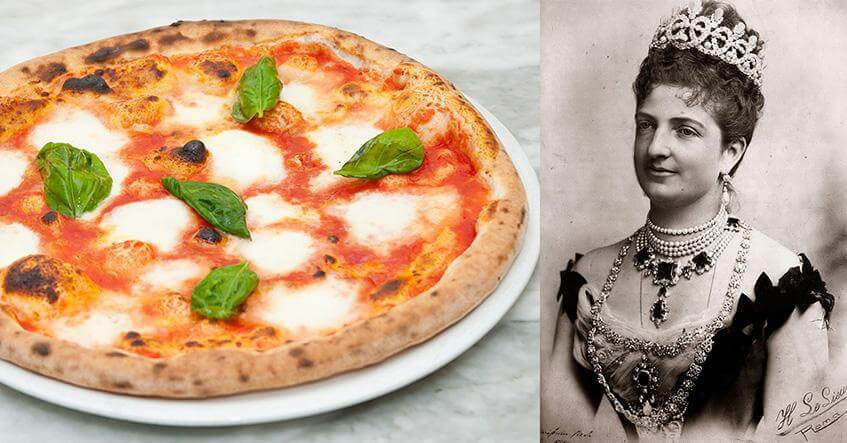 |
| Photo: Alfa Forni |
Legend has it that Italian Raffaele Esposito was the first to make that premier delicious pizza. Pizzeria di Pietro was the place where he did his magic. It is safe to say it was royalty commissioned. In 1889, the queen was visiting Naples.
To honor her, the leaders instructed Raffaele to make the signature food. Queen Margherita would get her dish, served as different types of pizza. They say after sampling each slice of the finger-licking goodness, she gave one a thumbs-up. A pizza whose ingredients had the colors of the Italian flag was her favorite. Italy named the pizza after her.
This approval would mark the beginning of a more respected pizza. That a queen can eat food considered to be for the poor, and like it meant this dish was truly Italian. Pizza soared, and Italians saw it as their own, ranking it in the same league as their beloved pasta.
However, it was not until 1830 that Naples got its first pizzeria – Antica Pizzeria Port’Alba. Pizza’s fame had not spread to the rest of the world as it remained contained in Italy’s borders. The lack of fame was the case until tourists visiting Italy asked for local cuisines.
The bakers offered them pizza. Therefore, this fast-food got yet another leap. Pizza marinara is a memorable one, for it was among those sought by tourists who had heard of its goodness. Often made by seamen’s wives, it would have oregano, garlic, and tomato toppings.
Increased popularity came at a cost, and people had to pay more for the delicacy as chefs began experimenting with a wider variety of toppings.
The love for pizza grew so much, Italians ate the dish at every meal. The new-found love happened by the close of the 19th century.
Who were among the people who enjoyed this taste of heavenly goodness? World War II veterans. Italians might as well have the soldiers to advertise it as they spread the word on the value of Italian pizza. Other spreaders of the pizza gospel were immigrants who took the story to the United States.
Soon, people stopped seeing the food as a poor man’s delicacy and an Italian-only treat, and the rest of America gradually began embracing it. Italian immigrants, proud of their roots, sold pizza on the streets. People would meet in pizzerias to talk and eat as pizzas became more popular.
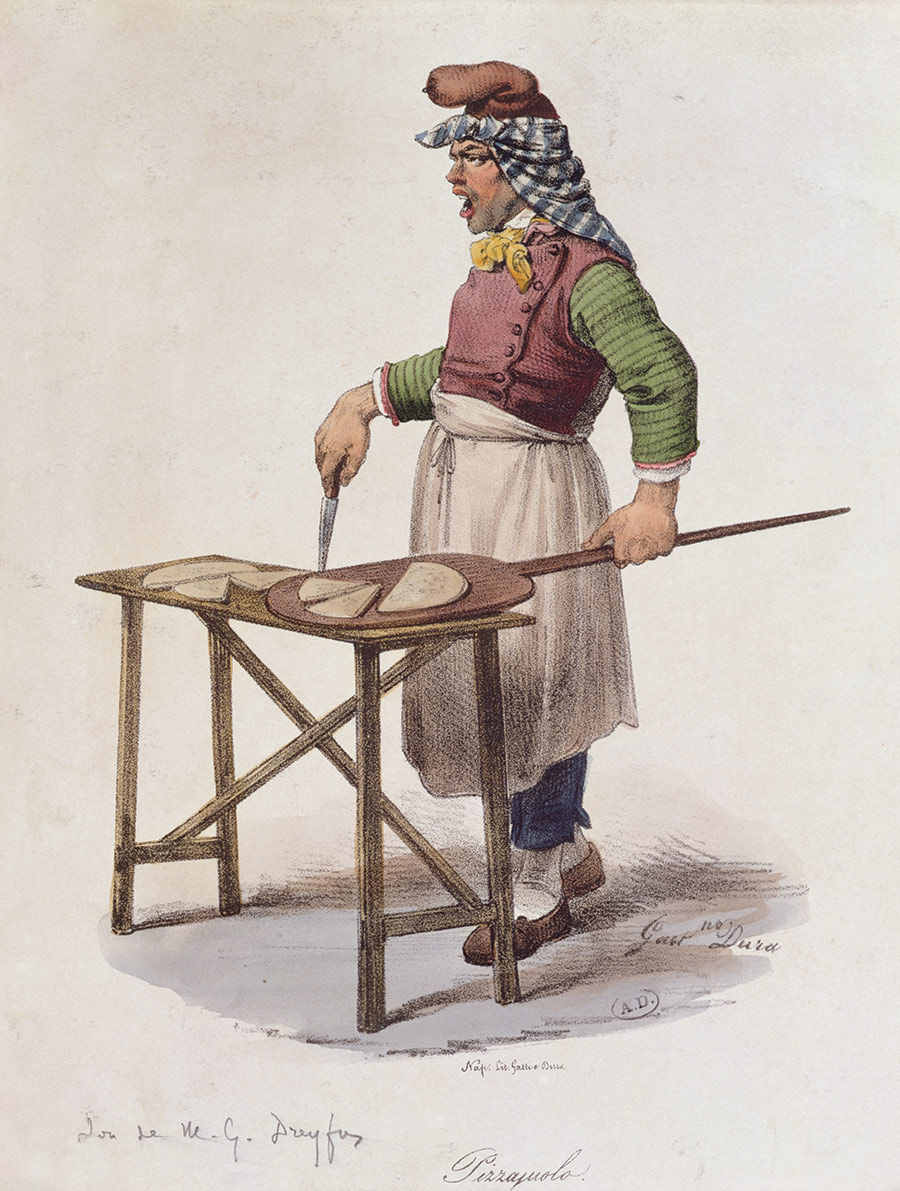 |
| Fast food outlet: a Neapolitan pizza seller, 19th century. Photo: Getty Images |
In 1905, Americans tasted their pizzeria when Gennaro Lombardi decided to open the first restaurant dealing in this delicacy in North America. Lombardi got the first American license to bake the dish. The popularity was thanks to street vendors who would sell pieces that they kept hot in charcoal-filled drums.
These restaurants would later mushroom in the USA, with Ric Riccardo Sr. following in Lombardi’s footsteps. He, however, started with a deep-dish pizza. It was Ira Nevin who gave pizza bakers an easier time in 1945. His invention of a gas-fired pizza oven removed the high cost and the inconvenience of using wood or charcoal.
The 1950s were a good time for this pie to flourish as the pizza restaurants’ premier chain was opened. It was also in the 50s that pizza chains opened, starting with pizza Hut in 1958. Little Caesar’s followed in 1959, and in 1960 Domino’s joined the fray.
In the middle of this pizza hullaballoo in the 50s, somebody realized that they needed to prolong the shelf life of pizza and started freezing it. Supermarkets took up the mantle and began stocking frozen pizza. Of course, by this time, people were making more money and could afford fridges and freezers, meaning they could also save some pizza at home.
Americans were also a busier population as the economy transformed, and fast food became the in-thing. People now sought convenience foods, and to meet this new need to keep pizza longer, bakers started using tomato paste instead of fresh tomatoes.
Today, over 70,000 pizzerias offer the U.S. delicacy, not to mention its popularity across the world.
What is pizza made of?
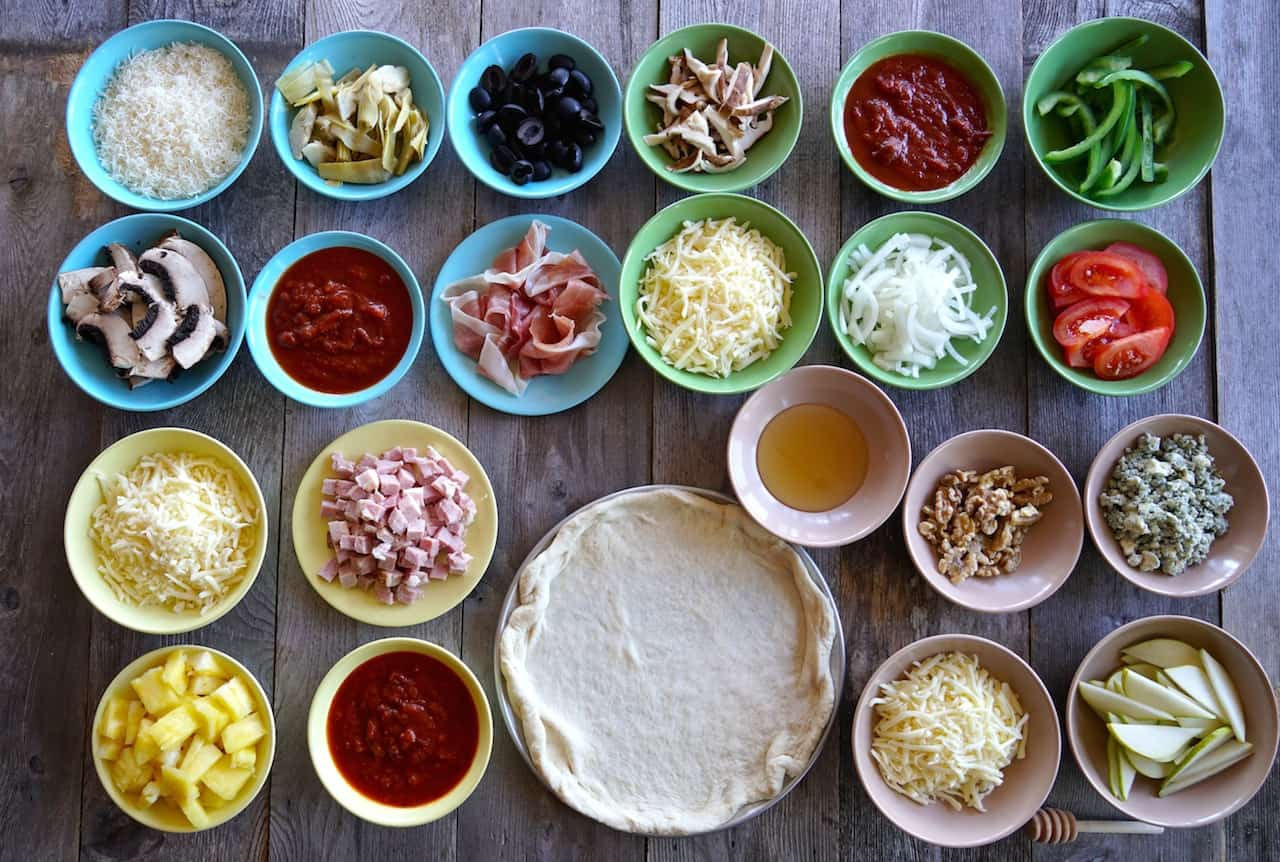 |
| Photo: Weekend at the Cottage |
Flour is ground from grain. All grains are composed of three parts: bran (the hard outer layer), germ (the reproductive component), and endosperm (the soft inner core). All three parts are ground together to make whole wheat flour. To make white flour, the bran and the germ must be removed. Since bran and germ contain much of the nutrients in grain, the white flour is often "enriched" with vitamins and minerals. Some white flour has also been fortified with fiber and calcium.
Yeast is a single-celled fungus. The variety Sacchromycetais cerevisae is cultivated for use in fermentation to produce alcoholic beverages and bread. Yeast enzymes allow its cells to extract oxygen from the starch in flour and produce carbon dioxide. The carbon dioxide then causes the flour to rise.
Baker's yeast is sold fresh in cakes or dried in powder form.
Mozzarella cheese was originally made from buffaloes' milk. In the Italian regions of Latium and Campania, it is still made this way, but the vast majority of mozzarella cheese is now made from cows' milk. It is stored in salted water or whey to keep it moist. For use as a pizza topping, the mozzarella is shredded.
Pizza sauce is made from pureed tomatoes seasoned with a variety of spices including garlic, oregano, marjoram, and basil. Both fresh and dried spices can be used.
The preparation of olive oil is as old as, if not older, than the that of pizza. Olives are gathered from orchards of olive trees and pressed to release their oil.
The list of pizza toppings is exhaustive. Meats include sausage, pepperoni, bacon, chicken, and pork. Vegetables include mushrooms, spinach, olives, broccoli, onions, green peppers, and artichokes. Some of the toppings may be partially cooked before being added to the pizza.
Different types of pizza
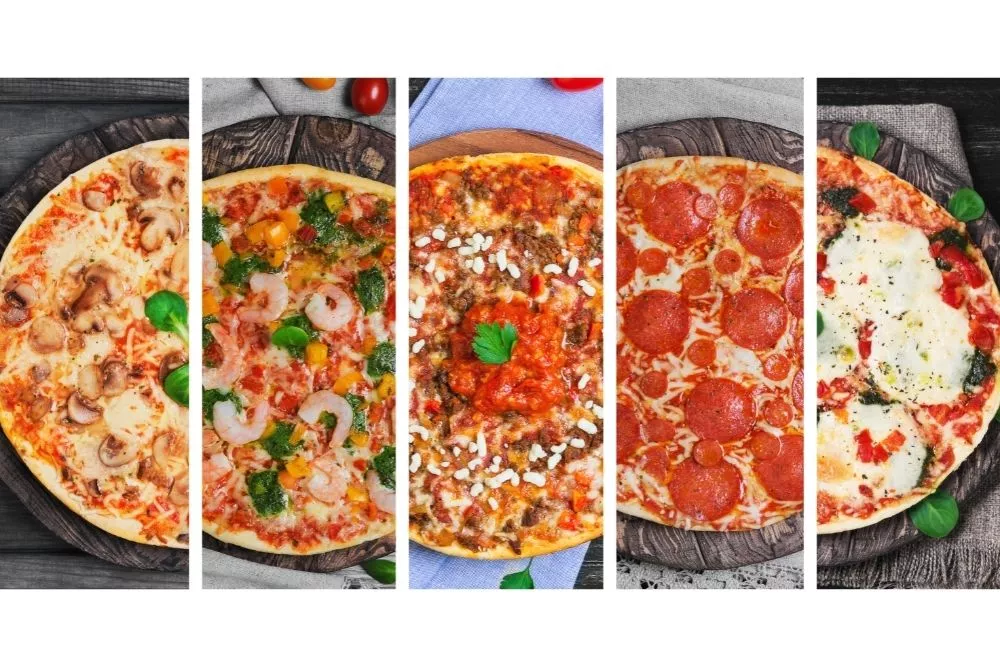 |
| Photo: Restaurant Clicks |
Italy has many variations of pizza. The Neapolitan pizza, or Naples-style pizza, is made specifically with buffalo mozzarella (produced from the milk of Italian Mediterranean buffalo) or fior di latte (mozzarella produced from the milk of prized Agerolese cows) and with San Marzano tomatoes or pomodorino vesuviano (a variety of grape tomato grown in Naples). Roman pizza often omits tomatoes (an early 16th-century import) and uses onions and olives. The Ligurian pizza resembles the pissaladière of Provence in France, adding anchovies to olives and onions. Pizza has also spread from Italy throughout much of the rest of the world, and, in regions outside of Italy, the toppings used vary with the ingredients available and the flavour profile preferred.
The popularity of pizza in the United States began with the Italian community in New York City, where the Neapolitan pizza had an early influence. The first pizzeria appeared in New York City about the turn of the 20th century. After World War II the pizza industry boomed. Soon there was scarcely a hamlet without a pizzeria. Sausage, bacon, ground beef, pepperoni, mushrooms, and peppers are traditional toppings familiar to many Americans, but ingredients as varied as arugula, pancetta, and truffles have found their way onto pizzas there. Variations are also often tied to different regions in the country, Chicago’s deep-dish pizza and California-style pizza among them.
How to make pizza: Step by step guide (Simply Recipes’s Tutorial)
Pizza Dough: Makes enough dough for two 10-12 inch pizzas
- 1 1/2 cups (355 ml) warm water (105°F-115°F)
- 1 package (2 1/4 teaspoons) active dry yeast
- 3 3/4 cups (490 g) bread flour
- 2 tablespoons extra virgin olive oil (omit if cooking pizza in a wood-fired pizza oven)
- 2 teaspoons salt
- 1 teaspoon sugar
Pizza Ingredients and Topping Options
- Extra virgin olive oil
- Cornmeal (to help slide the pizza onto the pizza stone)
- Tomato sauce (smooth or pureed)
- Firm mozzarella cheese, grated
- Fresh soft mozzarella cheese, separated into small clumps
- Fontina cheese, grated
- Parmesan cheese, grated
- Feta cheese, crumbled
- Mushrooms, very thinly sliced if raw, otherwise first sautéed
- Bell peppers, stems and seeds removed, very thinly sliced
- Italian pepperoncini, thinly sliced
- Italian sausage, cooked ahead and crumbled
- Sliced black olives
- Chopped fresh basil
- Baby arugula, tossed in a little olive oil, added as pizza comes out of the oven
- Pesto
- Pepperoni, thinly sliced
- Onions, thinly sliced raw or caramelized
- Ham, thinly sliced
Part 1: Making the pizza dough
1. Proof the yeast:
Place the warm water in the large bowl of a heavy duty stand mixer. Sprinkle the yeast over the warm water and let it sit for 5 minutes until the yeast is dissolved.
After 5 minutes stir if the yeast hasn't dissolved completely. The yeast should begin to foam or bloom, indicating that the yeast is still active and alive.
(Note that if you are using "instant yeast" instead of "active yeast", no proofing is required. Just add to the flour in the next step.)
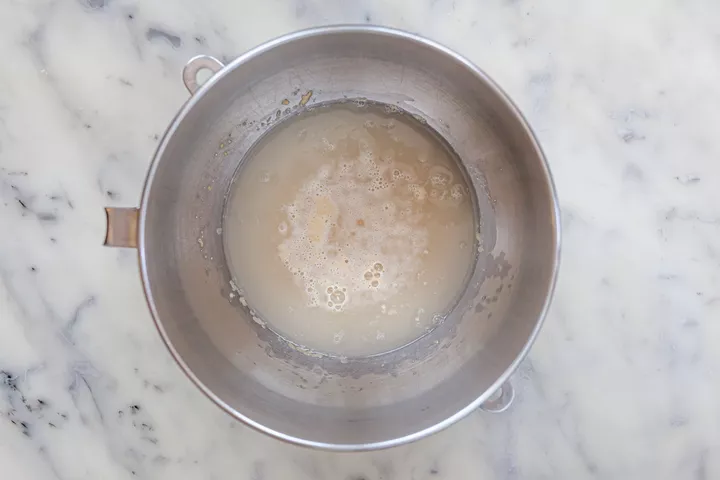 |
| Photo: Sally Vargas |
2. Make and knead the pizza dough:
Add the flour, salt, sugar, and olive oil, and using the mixing paddle attachment, mix on low speed for a minute. Then replace the mixing paddle with the dough hook attachment.
Knead the pizza dough on low to medium speed using the dough hook about 7-10 minutes.
If you don't have a mixer, you can mix the ingredients together and knead them by hand.
The dough should be a little sticky, or tacky to the touch. If it's too wet, sprinkle in a little more flour.
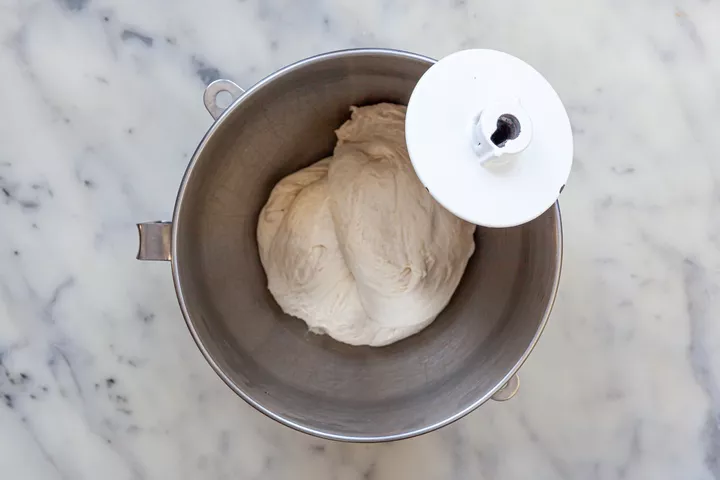 |
| Photo: Sally Vargas |
3. Let the dough rise:
Spread a thin layer of olive oil over the inside of a large bowl. Place the pizza dough in the bowl and turn it around so that it gets coated with the oil.
At this point you can choose how long you want the dough to ferment and rise. A slow fermentation (24 hours in the fridge) will result in more complex flavors in the dough. A quick fermentation (1 1/2 hours in a warm place) will allow the dough to rise sufficiently to work with.
Cover the dough with plastic wrap.
For a quick rise, place the dough in a warm place (75°F to 85°F) for 1 1/2 hours.
For a medium rise, place the dough in a regular room temperature place (your kitchen counter will do fine) for 8 hours. For a longer rise, chill the dough in the refrigerator for 24 hours (no more than 48 hours).
The longer the rise (to a point) the better the flavor the crust will have.
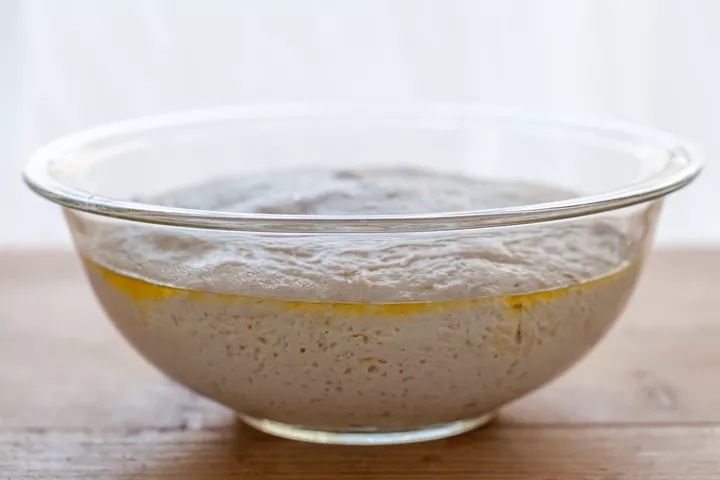 |
| Photo: Sally Vargas |
Make-Ahead and Freezing Instructions
After the pizza dough has risen, you can freeze it to use later. Divide the dough in half (or the portion sizes you will be using to make your pizzas). Place on parchment paper or a lightly floured dish and place, uncovered, in the freezer for 15 to 20 minutes. Then remove from the freezer, and place in individual freezer bags, removing as much air as you can from the bags. Return to the freezer and store for up to 3 months.
Thaw the pizza dough in the refrigerator overnight or for 5 to 6 hours. Then let the dough sit at room temperature for 30 minutes before stretching it out in the next steps.
Part 2: Prepare the Pizza
1.Preheat pizza stone (or pizza pan or baking sheet):
Place a pizza stone on a rack in the lower third of your oven. Preheat the oven to 475°F for at least 30 minutes, preferably an hour. If you don't have a pizza stone, you can use a pizza pan or a thick baking sheet; you need something that will not warp at high temperatures.
2.Divide the dough into two balls:
Remove the plastic cover from the dough. Dust your hands with flour and push the dough down so it deflates a bit. Divide the dough in half.
Form two round balls of dough. Place each in its own bowl, cover with plastic and let sit for 15 minutes (or up to 2 hours).
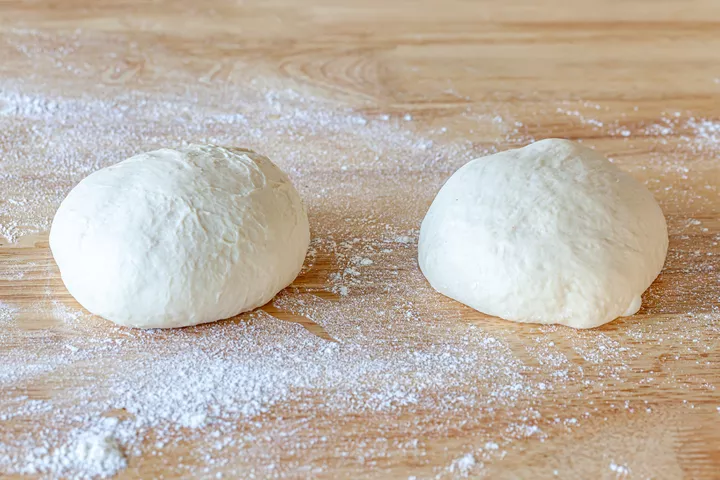 |
| Photo: Sally Vargas |
3. Prep toppings:
Prepare your desired toppings. Note that you are not going to want to load up each pizza with a lot of toppings as the crust will end up not crisp that way.
About a third a cup each of tomato sauce and cheese would be sufficient for one pizza. One to two mushrooms thinly sliced will cover a pizza.
4. Flatten dough ball, and stretch out into a round:
Working one ball of dough at a time, take one ball of dough and flatten it with your hands on a lightly floured work surface.
Starting at the center and working outwards, use your fingertips to press the dough to 1/2-inch thick. Turn and stretch the dough until it will not stretch further.
Let the dough relax 5 minutes and then continue to stretch it until it reaches the desired diameter - 10 to 12 inches.
Treat the dough gently!
You can also hold up the edges of the dough with your fingers, letting the dough hang and stretch, while working around the edges of the dough.
If a hole appears in your dough, place the dough on a floured surface and push the dough back together to seal the hole.
Use your palm to flatten the edge of the dough where it is thicker. Pinch the edges if you want to form a lip.
5. Brush dough top with olive oil:
Use your fingertips to press down and make dents along the surface of the dough to prevent bubbling. Brush the top of the dough with olive oil (to prevent it from getting soggy from the toppings). Let rest another 10-15 minutes.
Repeat with the second ball of dough.
6. Sprinkle pizza peel with corn meal, put flattened dough on top:
Lightly sprinkle your pizza peel (or flat baking sheet) with cornmeal. (The corn meal will act as little ball bearings to help move the pizza from the pizza peel into the oven.)
Transfer one prepared flattened dough to the pizza peel.
If the dough has lost its shape in the transfer, lightly shape it to the desired dimensions.
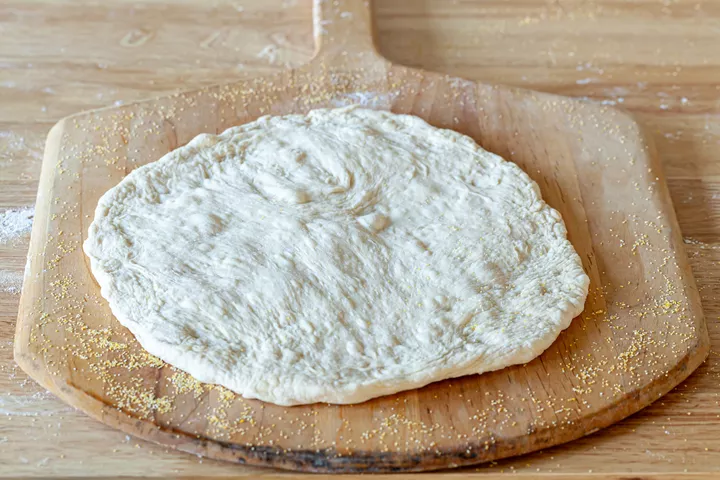 |
| Photo: Sally Vargas |
7. Spread with tomato sauce and sprinkle with toppings:
Spoon on the tomato sauce, sprinkle with cheese, and place your desired toppings on the pizza. Be careful not to overload the pizza with too many toppings, or your pizza will be soggy.
8. Sprinkle cornmeal on pizza stone, slide pizza onto pizza stone in oven:
Sprinkle some cornmeal on the baking stone in the oven (watch your hands, the oven is hot!). Gently shake the peel to see if the dough will easily slide, if not, gently lift up the edges of the pizza and add a bit more cornmeal.
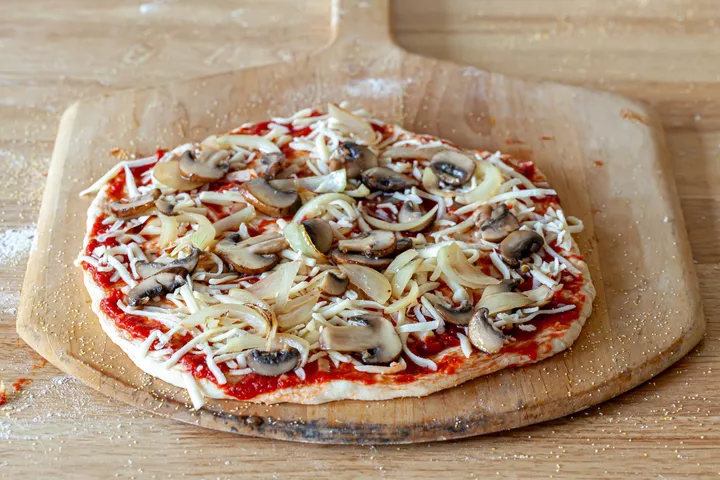 |
| Photo: Sally Vargas |
Slide the pizza off of the peel and onto the baking stone in the oven.
9. Bake pizza:
Bake pizza in the 475°F oven, one at a time, until the crust is browned and the cheese is golden, about 10-15 minutes. If you want, toward the end of the cooking time you can sprinkle on a little more cheese.
FAQS on pizza recipeWhat is the best flour for pizza dough?00 flour is considered to be a gold standard for making Italian pizza. It is pricey in many countries and is not easily available. So many pizza pros use bread flour. However all-purpose flour is widely used by home cooks as it yields similar results. If you prefer to limit refined flour, you may use fine white wheat flour or 50% all-purpose flour & 50% whole wheat flour. But use organic flour or at least unbleached & unbromated flour. How long to knead pizza dough?4 to 5 minutes of kneading the dough is good enough. But then everyone’s hand pressure is different so focus on the texture of the dough and not the time. Dough should be soft and when you press down it should dent and bounce back slowly. This is the indication of the dough being ready. Can you refrigerate pizza dough?Yes. After the dough rises, divide it to smaller portions as needed. Shape them to balls, cover and refrigerate. Refrigerate for 1 to 3 days. Bring it to room temperature before stretching it. Is it better to roll or stretch pizza dough?Rolling pin deflates the gas pockets in the dough and can make the pizza base denser. So pizza dough is always hand stretched. An easier way to stretch is to sprinkle some flour on a parchment paper or baking tray. Place the dough ball and drizzle little oil over it. Then stretch it using your fingers over the tray/ parchment paper. If you still want to use a rolling pin, then you may roll the dough until ¾ of the diameter. Then hand stretch the rest & create a border so it is not flat on the edges. |
 How To Be A Good Girlfriend In Simpliest Ways How To Be A Good Girlfriend In Simpliest Ways Being a good girlfriend is not always about cooking his favorite food or knowing how to do all the household chores. |
 How to Make Smashed Potatoes How to Make Smashed Potatoes Crispy smashed potatoes are everything a potato should be—a satisfying crispness on the outer edges, and absolute creamy perfection on the inside. |
 How to Make TikTok Pasta With Simpliest Steps How to Make TikTok Pasta With Simpliest Steps The ever-so-popular TikTok Baked Feta Pasta! How to make it in simple steps? Check out right below! |
 How To Make Birria Tacos: Best Tips and Tricks How To Make Birria Tacos: Best Tips and Tricks Loaded with juicy, chile-spiced, and succulent beef birria, this easy beef birria taco recipe is a real keeper. Check out the recipe of Birria Tacos ... |


























